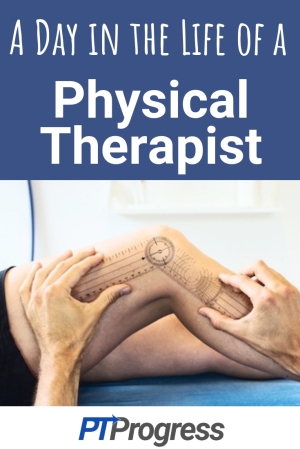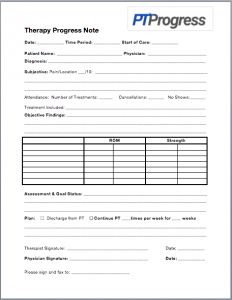
Today I’d like to share with you a typical day in the life of a Physical Therapist. Specifically, a PT who works in an outpatient clinic.
There are quite a few career options for Physical Therapists. You can work in a hospital, an outpatient clinic, and even a school. I’ve worked as a PT in the home health setting, hospital, and outpatient setting (both private and hospital owned). But this is a typical day for me as a Physical Therapist in a hospital outpatient setting.
A Day in the Life of a Physical Therapist
What to Expect: My Hours and Schedule
My full time, 40 hour a week position at a hospital is based on four, ten hour days (Monday-Thursday). I’m paid hourly, so every hour I work is compensated. Every hour I leave early or start late because of patient cancels or a low schedule, I’m not paid. There are pros and cons, but it’s nice to be compensated for the time you spend at work.
(As a salaried PT in a private practice or big name group, you are expected to do your notes after patient care. This may lead to a 50-60 hours a week schedule.)
7:40 Arrive and Pull Charts. Review the Day
My first patient is at 8:00 AM, so I like to arrive at least 20 minutes early to prepare the charts, open the computer and review the patients I have for the day.
It looks like I’ll be seeing 13 patients, which is a normal caseload in our clinic for a 10 hour day. The good thing is that we don’t ‘double-book’ here, so each patient gets one on one attention. Some visits are 30 – 45 minutes while evaluations are blocked for 60 minutes.
8:00 First Patient Arrives!
Today my first patient is an evaluation for a new patient. It’s not always an eval, but today it is and they arrived early to fill out paperwork. A good start to the day! When an eval arrives late, it can really throw off the morning because you feel like you’re trying to rush through things.
With my computer in hand, I welcome the patient to the clinic and walk her back to the eval room. I’ve already spent a few minutes reading through her chart and paperwork, but I’ll ask her to give me a history of what brings her in that day.
During the eval, we’ll cover her injury or diagnosis and history and assess items like range of motion, strength, balance, gait, and other special tests. This will help me to understand what’s going on and what recommendations I’ll provide in her initial home exercise program or plan (HEP).
The hour is coming to an end so I wrap up the eval and give her a scheduling recommendation to provide to the front desk. For her I recommended twice a week for 3 weeks, but this all depends on the diagnosis and severity of the injury.
9:00 Time for a Total Knee
My next patient is here on time for his 45 minute follow up appointment. We have the flexibility to recommend the length of treatment time and I recommended 45 minutes for him. He is one week out from a total knee replacement, so we have a lot of work to do!
I’ll spend 10-15 minutes passively moving his knee to increase range of motion. Then we’ll progress to strengthening exercises to improve his quad contraction. After some cues for gait (walking), we’ll add squats and work on stairs today. He’s still using a cane, so I’ll make note to progress his walking at the parallel bars next visit.
The 45 minutes went by fast and I’ve recommended that he apply ice and elevate for at least 10 minutes. Our Rehab Aide sets this up for him and lets him know when he’s done with ice.
During this visit, I was able to do a lot of his note (or documentation) while I worked with him. The major items I need to document include a Subjective, Objective, and Assessment / Plan. This is a SOAP note format and provides a snapshot of what we did during the treatment.
9:45 – 12:00 A Mini-Marathon of Patients
Four more patients are on my schedule until noon. Their diagnoses vary from shoulder injuries to low back pain (LBP). If I had to estimate the percentage of cases that I see based on body part, I’d list it as follows:
- 40% Low Back Pain
- 25% Knee & Hip Pain (Including Total Joint Replacements)
- 25% Shoulder Pain (including Rotator Cuff repair)
- 10% Neck / Ankle
In our clinic, about 25% of cases are post surgical. This means, they are here because they’ve recently had surgery.
12:00 Another Evaluation (New Patient)
Another evaluation is scheduled for noon today. I like having a eval at 12 because I usually take my lunch around 1:00. In our clinic we have 30 minutes for a lunch and 30 minutes for documentation, so a full hour is blocked off for ‘lunch.’
This works great for evaluations because I like being able to write out the eval as soon as I can. It takes me about 15 to 20 minutes to type it up and send it to the physician. They need to sign the plan of care which explains what I plan on doing with the patient during future treatments.
1:00 Lunch and Paperwork!!
It’s lunch time and paperwork time. I’ve spent the first 20 minutes typing up the 12:00 eval and then typed up the notes from the previous 4 patients. I was able to keep up with some of the ‘daily notes.’
Daily notes are performed with every follow up treatment. It’s the most ‘basic’ of notes. PTs also have to do progress notes and discharge notes. I think I have one of each in the afternoon, so we’ll cover those in a second.
We’re halfway done with the day! Taking my lunch later makes the day go by faster in my opinion 🙂
2:00 Hmmm, where is my patient?
It’s actually 2:05 and my patient isn’t here yet. They’re scheduled for a 30 minutes follow up and someone else is coming in at 2:30.
It is up to the therapist to decide if they are able to provide treatment for the patient if they’re late. I am very punctual and rarely bring a patient back late to their appointment. Since I run a tight ship, I cannot shorten the appointment after this one because my 2:00 patient is late.
It’s 2:07, he arrived for his appointment, so I’ll bring him back and get started right away.
2:30 Ugh, the patient cancelled.
Patients cancel almost every day. In fact, we can expect about a 10% cancel / no show rate in our clinic every day. Sometimes it’s lower, but on snowy days or near holiday weekends, it can be as high as 15 or 20%.
Decreasing cancellations and no shows can be done with appointment reminders and even text messages, but we currently don’t have an automated system for appointment reminders.
3:00 to 5:30 The Final Stretch!
For the next two and a half hours, I’ll see four more patients. Two of these patients are ‘follow up visits’ that require a simple daily note. One of the patients needs a progress note.
Progress Notes are a re-check of range of motion and strength as well as other special tests. I’ll send the progress note to the doctor for review and put my recommendations for continuation. We’ll review the goals we set during our evaluation and schedule any additional appointment based on my recommendation.
My 4:45 patient is last on my list of patients and it’s actually her last scheduled appointment. She’s done very well and reports that her knee pain is completely gone. We’ve worked together for the past 3 weeks and she’s had 7 total visits. She’s back to running and feels confident with the exercise program that we put together for her to do at home.
Since she’s met all her goals and is comfortable with her home exercises, I recommend that we do a Discharge Note today. This note will collect all the data for ROM, strength, and other movement tests and update her doctor on her successful treatment. She follows up with the doctor in a week, but I’ll fax over this note today so they have it in her records.
5:30 – 6:00 Phew, I can see the light!
Well it’s actually dark outside because it’s winter in Michigan. But I’m done with patient care and have kept up pretty well with my documentation.
The daily notes only take me about 5 minutes and I can complete most of it during the patient’s visit.
The Progress Notes and Discharge Notes take me 10 to 15 minutes if I have to print and fax and file the notes. Thankfully, our clinic sets aside time at the end of the day for us to complete our notes.
6:15 Done for The Day!
Today I saw 12 patients which included 2 evals, one progress note, and one discharge. These 10 hour days are a bit long and you feel pretty tired at the end of the day. I’m on my feet for most of the day, rolling around a computer as I treat my patients. Taking time throughout the day to perform stretches myself is important so that I don’t become a patient myself!
While some PTs may relate to this day, others may have a completely different day as an outpatient therapist. If that’s you, I’d love for you to share an article that highlights a day in the life of a physical therapist in your clinic.
Check out more resources on how to become a physical therapist here.


